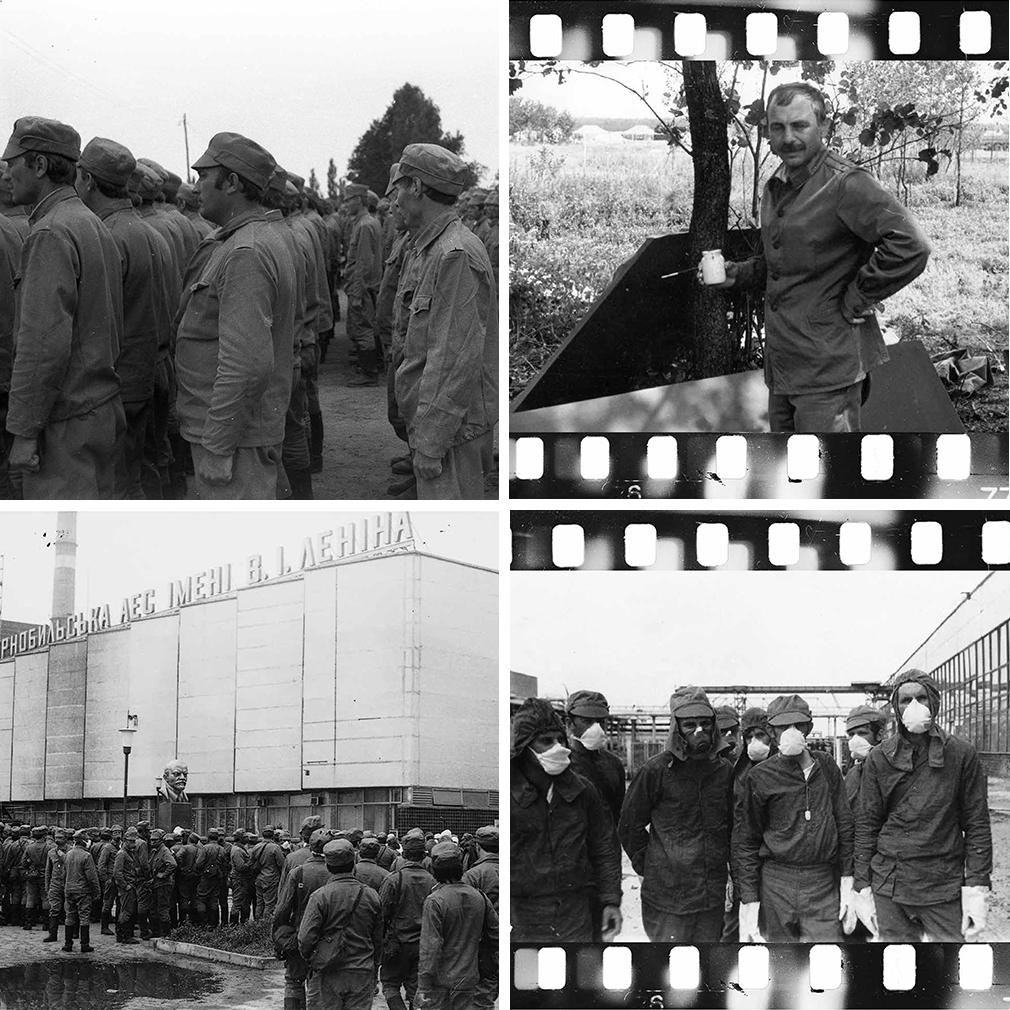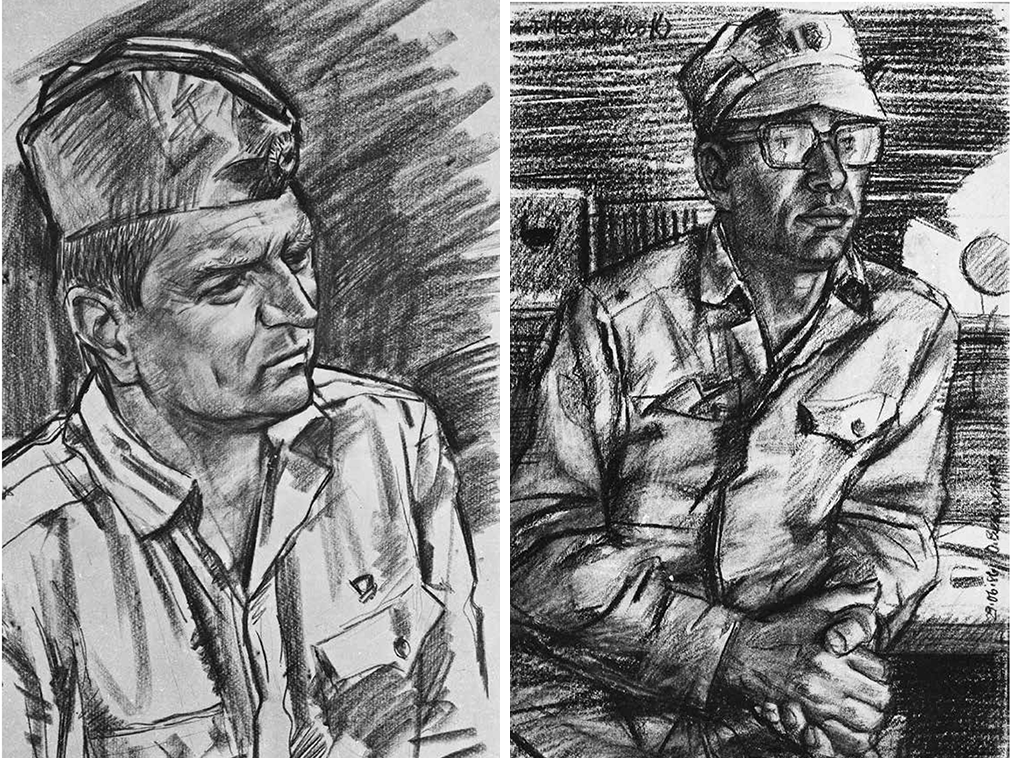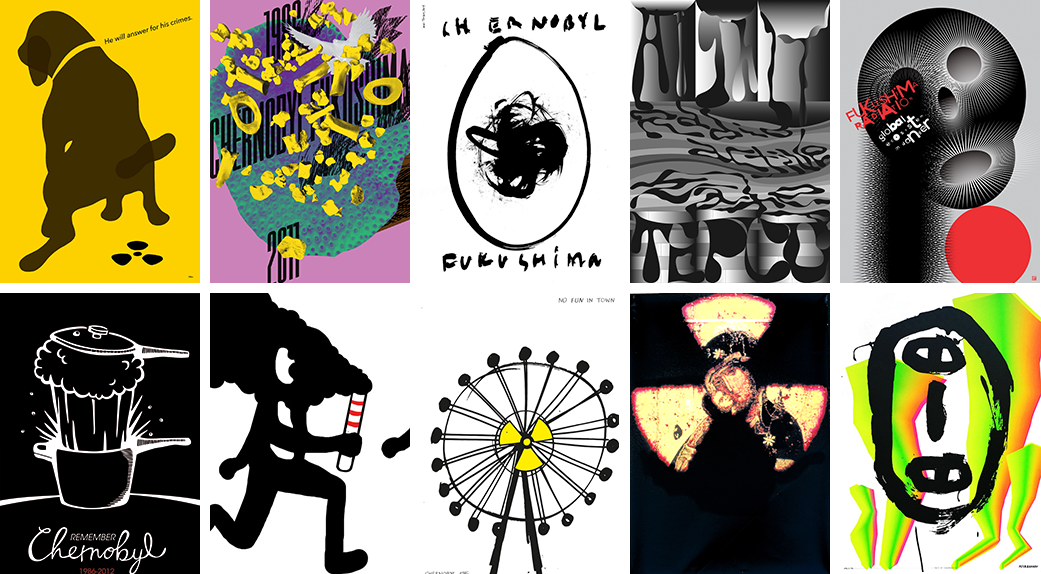
Photos taken at the site by Oleg Vekleno (who is picture in upper right)
The recent HBO mini-series “Chernobyl” offered a dramatized yet no less chilling view of the human toll exacted by this nuclear tragedy that stopped the entire world dead in its tracks. A new book published in Ukraine, Oleh Veklenko Chornobyl: Sketches from Nature, is a remembrance and memoir of Oleg Veklenko, a Ukrainian graphic designer conscripted into the cleanup and mitigation near the exploded Chernobyl nuclear reactor in the first “hottest” two months of accident. In no small way this surreal event motivated him (a lieutenant at the time) to become the co-founder and President of “The 4thBlock” International Eco Poster and Graphic Triennial (Kharkiv, Ukraine). In February another book will be published in the Ukraine on the history of the creation of the 4th Block. Currently, Veklenko is leading a “4th BLOCK” initiative: an international poster campaign to support the “Zero Corruption Conference” occurring in Kyiv and Chernobyl in April, 2020. (The name relates to the block where the deadly fire occurred). The event aims to show the connection between corruption and money laundering and environmental, economic, and regional security problems. I was introduced to Veklenko (thanks to Mirko Ilic) through an email and a PDF of the two books. Below I ask him but a few of the many questions I have about how he turned the unimaginable experiences at Chernobyl into a proactive cautionary force.
I am unable to share the entire content of Chornobyl: Sketches from Nature, which includes photographs, drawings, and compelling text but here is an example Veklenko’s voice and some of the images he photographed and drew:
An image of the dog, running around our camp, strikes my mind immediately. It was called Radiation. Later, a cute dog named Roentgen appeared, and there was Dose, too. One more radiation association from this category: a little pig in the respirator, trotting along Chornobyl streets in May, when someone played a lame joke on the poor animal. Well, to be serious, before Chornobyl, like most people mobilized there, I knew about such a phenomenon as much as the textbook in Physics for the 8th grade provided. On one of the first days a major from Kyiv, we were unfamiliar with, probably with the mission to inspect (a lot of them came to the camp for an hour or two to flash and give some orders), was walking among the tents with a dustproof respirator “Peliustka” around his neck and explaining cheerfully: “In case you feel the wind be ine!” But we didn’t have any respirators then, only those who went to the area to do the task managed to get an army foam respirator.
That was in the camp, 30 km from the reactor... Even at the nuclear power station, nearby the destroyed “block”, people came out of the buildings into “fresh air” to have a smoke. And what if they had to give an order, to discuss the task within limited time? In such a situation not many of them bore in mind the invisible danger. In addition to that, there was heat, dripping sweat, permanent inner tension due to the presence of a terrifying, unknown monster nearby. You would know about the [radiation] dose you had received in the evening when you returned to the camp and had your device checked with special equipment. My device was attached to my belt, of course, but I met people who carried theirs attached to the boots, closer to the ground. I am not sure if it made any difference.

Sketches by Oleg Veklanko of officers and soldiers in the cleanup battalion.
Steven Heller: How did you get conscripted into the clean-up battalion at the Chernobyl atomic plant?
Oleg Veklenko: After the end of the service in the Soviet Army, which every young man had to go through in the USSR, I became a reservist and was attached to the military unit of chemical and radiation protection. Naturally, when the disaster at the Chernobyl nuclear power plant happened, all the reservists, including me, were urgently collected and sent to Chernobyl.
SH: How long after the accident?
OV: We turned up in Chernobyl 6 days after the explosion.
SH: What were your duties?
OV: Since I had a higher art education and an officer rank, I was appointed head of the mobile club. I had to organize a quality rest for the soldiers working in the accident zone, deliver them mail, show a movie, maintain morale, create a good mood, and much more.
SH: How long were you assigned to this job?
OV: I stayed in the Chernobyl disaster zone for 2 months and was sent out of the zone after I received 25 x-rays.
SH: Did you have an ill health reaction?
OV: Yes, but it happened a little later, after returning from Chernobyl. Long-term health effects are manifested even now, but this is another story and I prefer not to talk about it.
SH: At the time of your conscription, where you a graphic designer?
OV: In Chernobyl, I did not work as a graphic designer, although I had to design a camp where we were all this time. As a graphic artist, I tried to paint whenever possible.
SH: When did you start the 4th Block poster initiative?
OV: Five years after the Chernobyl disaster, together with friends and colleagues, we decided to mark this event with an international exhibition of posters. After the first exhibition, we organized an exhibition once every three years. This is how the triennial, which we called the “4th Block”, arose (in memory of the 4th block of the Chernobyl nuclear power station at which the explosion occurred).
SH: What is your goal?
OV: With the help of posters, to recall the dangers of nuclear energy, man-made and environmental disasters, and that we all live on a small fragile planet that must be protected and preserved. (Another attempt, most likely futile, is to change the human mind towards environmental thinking.)
What is our goal? All the countries on their way to democracy have to fight hard with corruption. Millions of their citizens stand for justice and democratic values. However, powerful political and business barons actively oppose this movement. These processes are especially evident within the former soviet state and in Ukraine particularly. The transition to democracy cannot happen in developing countries without profound changes in the rest of the world. Kleptocrats from poorer countries acquire assets, real estate, and invest in the business of developed countries. So, venal practices penetrates into financial system of the Western countries and infects the foundations of an open society. A vicious circle of dirty cash flows challenges the democracies of the entire planet. How can we build a zero corruption future together?
Projects goals
Unite the designers of the world and all the forces of good will in the fight against global negative challenges.
Influence politicians and government agencies to address these issues.
Foster the growth of moral awareness and social cohesion.

SH: You’ve assembled thousands of posters on all kinds of social causes?
OV: Each time we come up with a new concept for the triennial, a sharp and relevant topic (not only Chernobyl and Fukushima). This is a good opportunity for designers to express their attitude to various social and environmental issues with the help of a poster. This is probably why we get so many posters from different countries every time.
SH: What was the response to the call for Chernobyl posters?
OV: For the first triennials there were many posters dedicated to Chernobyl. Later, graphic solutions began to be repeated and exhausted themselves. Fukushima gave a new surge in anti-nuclear posters. But now we are increasingly focusing on environmental issues.
SH: From how many countries?
OV: Our collection has posters by designers from 56 countries.
And to sum up the Zero Corruption Conference, Veklenko writes:
Corruption as a threat to global security. People all over the planet feel insecure. We see a continuous standoff between truth and false information, autocracy and democracy, human rights and the right of power, the free world and closed societies. Dictators and criminal lords challenge the idea of a liberal democracy that has ensured relative stability and peace during last 70 years. Sustainable peace and safety constructed of the ashes of great wars of the 20th century, began to totter and demand changes.Deadline for the poster exhibit is February 29. The project will take place in April, 2020, at the International Forum of Zero Corruption Conference in Kyiv, in the Arsenal Art Center. A part of the exposition will be demonstrated in Chernobyl. The project will resume within the XI International Triennial of Eco-Poster, The 4th Block, in Kharkov in April, 2021. A catalog will be available.

